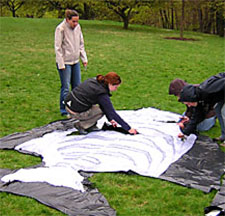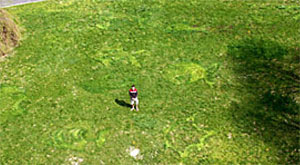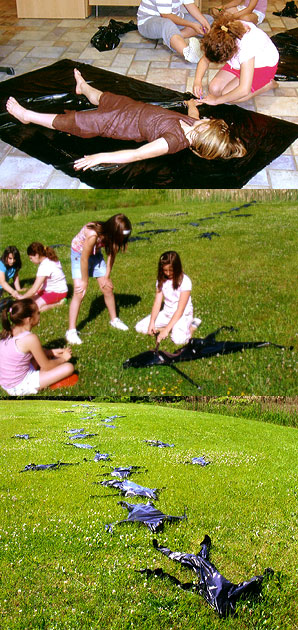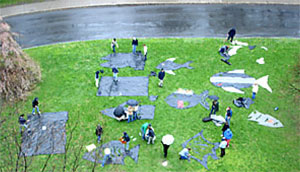 Playing
with Light: Temporary Lawn Patterns
Playing
with Light: Temporary Lawn Patterns
 Printable
PDF version
Printable
PDF version
Many
artists today are playing with the ephemeral: work
that doesn’t last, although it can be captured
with photographs. Although we often like to create
lasting works of art, sometimes it’s fun to
make a big, dramatic, yet fleeting splash. Using black
plastic on a swath of lawn allows you to temporarily
burn the color out of a lawn to reveal a yellowish
pattern against a green background.
 Time
Required
Time
Required
Planning: depending on group and project, anywhere
from a half hour to an hour and a half.
Creating pattern: 1-4 hours depending on the complexity
of your design
Directions
This technique deprives grass of light, which will
change its color to pale shades of green, yellow,
white, or rippled effects of a combination of these.
When deprived of light, chlorophyll, which gives leaves
their green color, fails to function. When leaves
don’t produce chlorophyll they lose their green
color. As long as you don’t leave your black
plastic down too long, your design will indeed be
fleeting with grass regaining its color within a few
days. Checking a corner of one piece of plastic will
be necessary to prevent the lawn from being killed;
the length of time required to create a pattern will
vary greatly depending on climate, sunlight, and temperature.
It make take a day or a week.

As
a background planning step for this effort, you may
want to find a site at which the design can be viewed
from a height. For example, a park lawn adjacent to
a tall building is ideal. Planning an opening celebration
for when the design is “revealed” can
be an exciting element of the project.
 Playing
with Light: Temporary Lawn Patterns
Playing
with Light: Temporary Lawn Patterns 
 Materials
Materials Time
Required
Time
Required